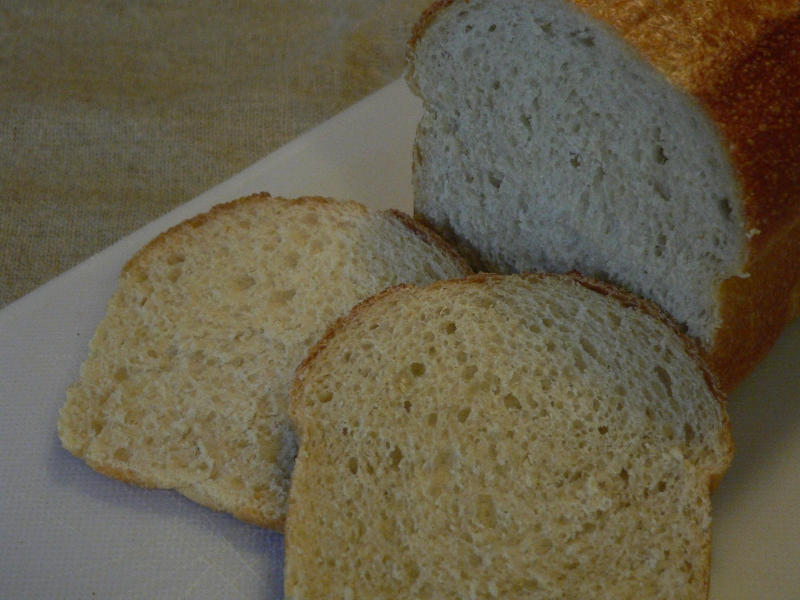Apricot Yeast Water Test Loaf [Update:110530-1000]
If you are unfamilar with Yeast Waters, and wild yeast, you may wish to view
Yeast Water & Other Wee Beastie Bubbles (No Math)
http://www.thefreshloaf.com/node/23441/yeast-water-amp-other-wee-beastie-bubbles-no-math
This was my first chance to test Apricot Yeast Water. I have intend to for a while, but wanted to wait for fresh fruit to be available. I did find some this week and started a culture with 3 of the small fresh apricots, jump-started the culture with a bit of my Apple YW.
I have heard that the dark dried apricots make a very strong levain – the more common dried fruit that are a yellowish orange have been treated with sulfur-containing compounds to keep their color (and kill the WBBs). So, the only dried apricots to use are the dark brown unsulfured fruit. Not wishing to waste time and effort, I wanted fresh, organic apricots, which start being available May through August in the northern hemisphere.
I was impressed with how fast the culture became active, and equally surprised how fast the activity ended. I tasted the YW to see if, somehow , it had gotten too alcoholic so fast. All I detected was no noticeable sweetness, and decided it must be a lack of sugar. I dropped in a sugar cube and within a very short time it became very active – so much so, that I feared the foamy head might fill the remaining air space in the glass container. It did not take long before the activity decreased nearly as fast as it had restarted.
It only took a few trials to conclude the apricot WBBs have a real thing about sugars. So, I decided to do a test of the leavening strength of the new culture. I took a small quantity of just the water, about 20g and mixed it with an equal amount of AP flour. I set this up with a clock beside it, and in front of a time lapse digital video recorded. You can see the results on YouTube, Link:
http://www.thefreshloaf.com/node/23719/time-lapse-video-apricot-yw-levain
The result was a doubling in about 2 hours. Certainly a good showing for a brand new YW culture. So, a test loaf seemed quite justified.

I started the Apricot Yeast Water Levain (AYWL) builds. Details of my standard test loaf can be found here:
http://www.thefreshloaf.com/node/23694/standard-kiss-loaf-or-keep-it-simple-smiley
Details of this loaf are in the table below:

A copy of my personal test log can be found at Google Doc Link:
https://docs.google.com/viewer?a=v&pid=explorer&chrome=true&srcid=0B_MScoZfDZkwMTIyM2E1ZjQtYWFlMi00Y2I5LWFiYTktMWI5ZGMzYTgzMzgw&hl=en_US
I had some surprises in store, however. I generally, hold each of my chosen 3-build levain developments to a 24 hour period. Instead, a late afternoon to early evening completed Builds-#1, and #2 with #3 started and placed in retard at 40ºF/4.4ºC for an overnight. Details can be found in the log.

The next morning, I did the shaping that basically matches the pan bread version detailed by txframer here:
http://www.thefreshloaf.com/node/20669/sourdough-pan-de-mie-how-make-quotshreddablyquot-soft-bread
The dough pan was covered with food cap and place in the proof box at 82ºF/27.8ºC. Most loaves that I do, which are similar to these conditions, will need a 6 hour final proof. I was rather shocked when at 4½ hours I found it was as high as any “normal” fully proofed dough. I did a rapid catch-up and dough was in the DO, with the cup of boiling water, and into the oven, within a 5 minute period. Again, details can be found in the PDF log.
From a cold oven start and oven set to max (450ºF/232ºC) in the DO it was steamed for 20 minutes. Lid removed at 20 minutes and the temperature dropped to 400ºF/204ºC with a total of 45 minutes for the baking.
The finished loaf had an internal 207.7ºF/97.6ºC and a hot weight of 437g – down 8% during the baking. The loaf was cooled on wire for over an hour, before cutting.

The loaf had a very nice aroma, but neither taste, nor smell indicated the apricot components in the loaf. The crumb color was softly off-white in the orange-brown range, but only in a small degree. Texture was moist and softer than my general SD loaves. A pleasantly fruity, slightly sweetish flavor. The top crust portion was chewier than I would have expected, but quite acceptable.
I should, also mention, I could detect no tang at all. I had expected a bit from the apricot flavor itself. But, any tang vanished along with any apricot specific flavor.

The crumb was exactly as expected, given the 60% HL (hydration level) and the highly developed windowpane test it was kneaded to.
Based upon this single test loaf, apricot WBBs develop much stronger levain than any I have seen before. The Apricot YW rise times are somewhere between 25% faster, or if you are one of the half empty glass types, the other Yeast Waters are 33% slower ;-)
Update:110530-1000I have just had a couple additional slices of this Apricot YW loaf. In the 23 hours since baking, there has been a flavor change. It is still quite pleasant, but definitely less sweetness. The change is hard to describe, but while it is NOT "astringent", that is the closest word I can think of to describe the very slight difference in flavor. My initial reaction was
'use a bit less than 2% salt, next time'.
Ron